Ladybirds in Worcestershire
Text by John Meiklejohn
Maps from the Worcs BRC data base prepared by John Partridge
using DMAP software. The outline is of the Worcestershire Vice-county,
which is roughly the Victorian county, and now includes parts of
the West Midlands.
The coloured square shows that we have a record from that 2 km
x 2 km square. The blue lines are motorways, the red A-roads, and
the dotted lines rivers and canals.
In Britain there are 46 beetle species in the Coccinellidae,
the ladybird family. Of these, 26 species in three sub-families
can be called ladybirds: Coccinellinae, Chilocorinae &
Epilachninae. The remaining 20 species, which do not resemble
ladybirds, form three further sub-families: Rhyzobiinae,
Scymninae & Platynaspinae
In the Worcestershire Biological Records Centre there are
records for 19 of the ladybird species. The distribution maps
show that we need more records!
Most ladybirds are carnivorous, both adults and larvae feeding
on aphids and other small, soft-bodied invertebrates. The 24-spot
and the recently introduced Henosepilachna argus are
herbivorous; both are hairy too. The 22-spot, 16-spot and Orange
ladybirds feed on mildews.
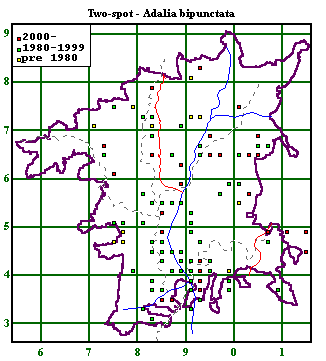 Common. Unlike the 7 spot,
there are several different colour forms of this species
The commonest variant is black with four irregular red
spots
|
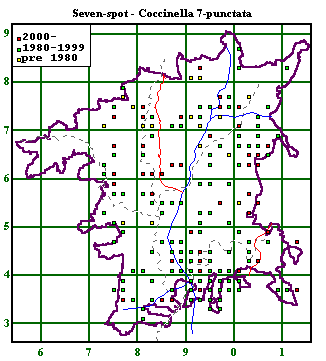 Common. The females are
generally much larger than the males
|
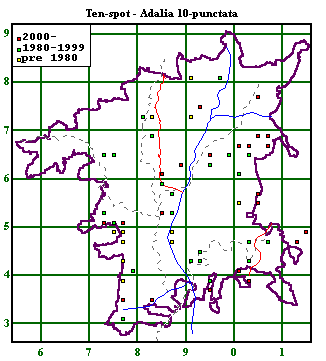 Common. Many different colour
forms but the pronotal markings are fairly consistent
|
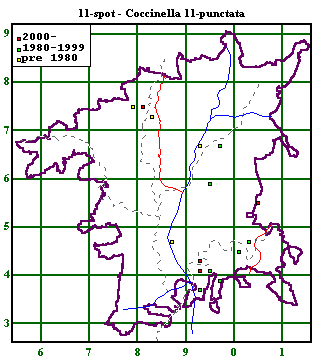 Usually in plant litter,
commoner in coastal areas
|
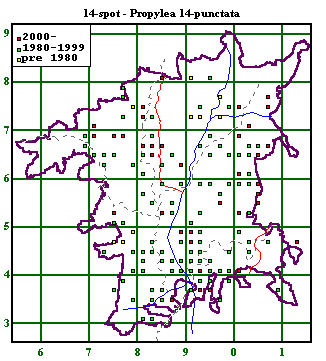 Elytra yellow with distinctly
squarish black markings. Probably our commonest ladybird
widely distributed in Worcestershire. Less conspicuous
than the 7 or 2 spot
|
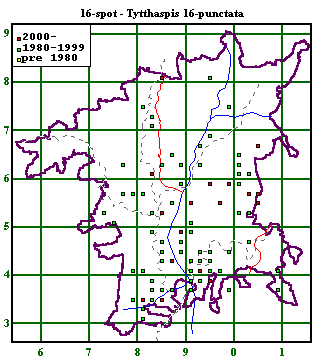 A very small ladybird with a
black line down the suture of the elytra. Large numbers
sometimes found together in winter hibernacula
|
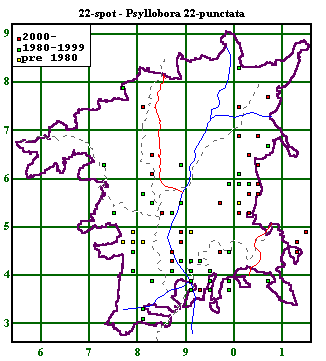 Small, bright yellow. Not
very active, usually close to the ground
|
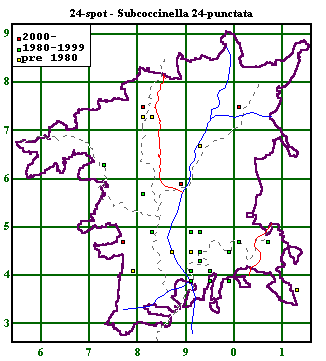 Small, hairy, phytophagus
species usually in rough grassland
|
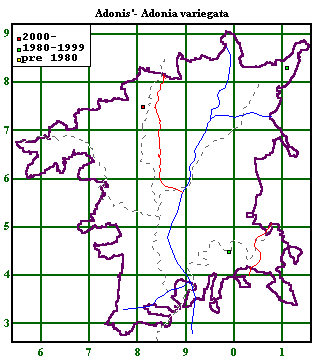 Uncommon species usually on
sandy soils
|
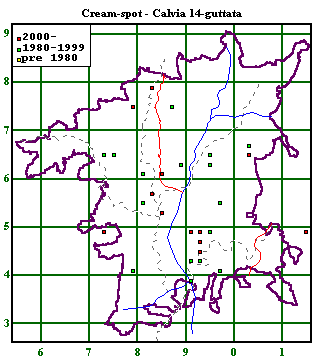 Seven whitish spots on each
elytron, brown or reddish-brown ground colour
|
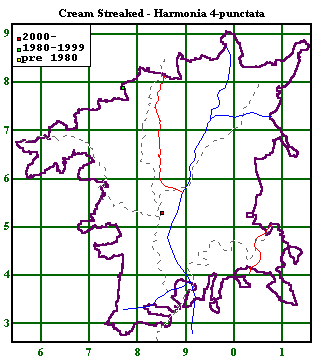 Uncommon species on Scots
Pine
|
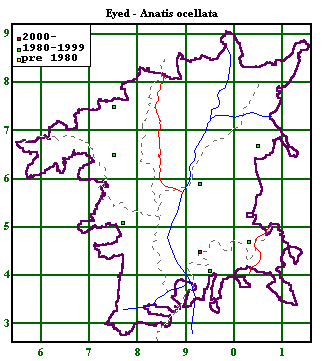 A large ladybird usually with white edges
to the elytral spots. Coniferous woodland.
|
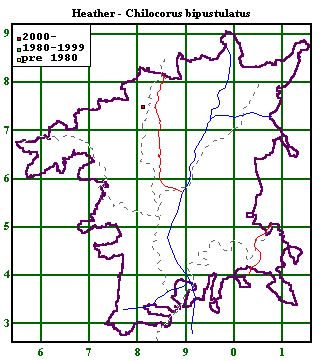 A heathland species similar
to the Kidney-spot, much smaller, 3 or 4 spots in a row
|
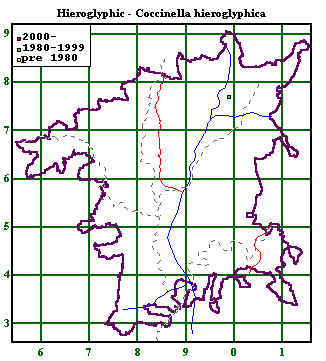 Uncommon. Heather heathland.
(Worcs. record swept from Ling, Lickey Hills, 1991 )
|
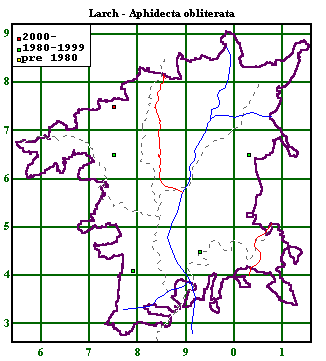 A coniferous woodland species.
No spots, a distinctive M-shaped mark on pronotum
|
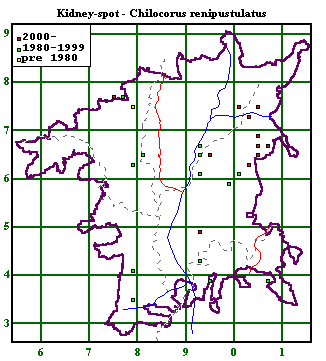 One of three black ladybirds
with red markings and with a definite lip around sides of
elytra. Often found on deciduous tree trunks
|
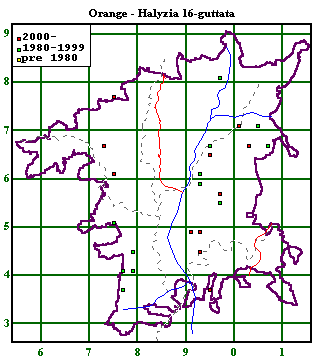 Eight whitish spots on each
orange elytron. Considered nationally scarce ten years
ago and associated with Sycamore, now more common.
Overwinters in leaf litter
|
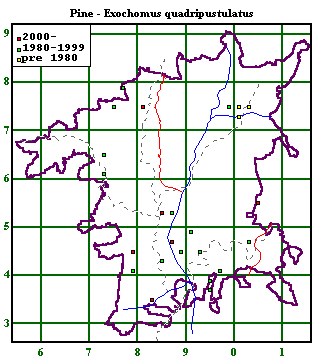 A coniferous woodland species
similar to the Kidney spot but with two spots only
|
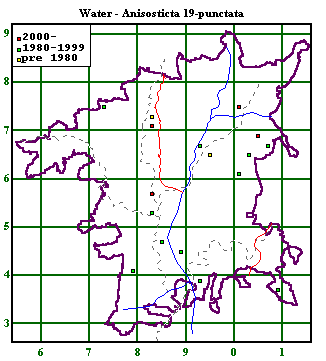 A long, narrow ladybird found
in Reed and Bullrush beds
|
|
An Alien ladybird Turns Up In Worcestershire - Cheilomenes
lunata
In the first week of January 2002 a very unusual ladybird
arrived at the Worcestershire Wildlife Trust Headquarters at
Lower Smite Farm. Glenys Anderson from Worcester had found it in
a bunch of grapes that she had bought from a Tesco store. It was
identified by Paul Whitehead as Cheilomenes lunata, an
African species. This was the first sighting outside the Thames
catchment area.
E-mail correspondence revealed that three specimens had been
found by 14th January, all in grapes sold by Tesco. By the 8th.
February there were seven reports of it including one from Wales,
one from Essex and then one from Perth in Scotland. This last
specimen was found in grapes from an Asda store. It has been
established that the distribution centre for Welsh grapes was in
Sheerness in Kent. Were all the finds from one importation?
There is no telling just how many of these ladybirds may have
found their way into the wild but it is unlikely that they will
be able to survive.
(As we go to press a short report has appeared: Mabbott,
Paul, 2002 Reports of Cheilomenes lunata (Fab.) (Col.:Coccinellidae)
in Britain - winter 2001-2002. Ent. Record &
J. Variation. 114(3):121-122. Apparently it is an aphid-eating
Afro-tropical species which is found as far south as Cape Town.
All the British records appear to stem from a batch of grapes
imported into Sheerness, East Kent, and there were many in some
boxes).
Its main plant food in Britain appears to be White Bryony but
it has been swept from dense Ivy with Honeysuckle

|
Cheilomenes lunata. African ladybird found in
Worcestershire.
In the picture the pale areas are orange and the dark
areas black. See text. |
A Ladybird To Look Out For -Henosepilachna
argus.
This ladybird was first seen in Surrey in May 1997
where is has now established a strong breeding colony and
one has been found near Stratford-on-Avon. It is a
relative of our 24-spot ladybird, a plant feeder and with
hairy elytra. It is 6-8 mm long, bright amber in colour
with eleven black spots.
|
If you would like learn how to identify ladybirds, and more
about them, an excellent book is Ladybirds of Surrey by
Roger D Hawkins. Published by the Surrey Wildlife Trust 2000
The value of this book extends far beyond Surrey. There are
excellent colour photos, including the Bryony Ladybird.
Also Majerus MEN & Kearns PWE 1989 Ladybirds.
Naturalists' Handbook 10. Richmond Publishing, also contains much
information and a complete identification key.
